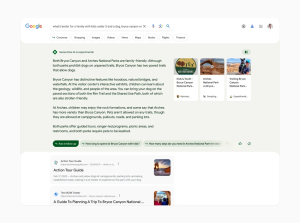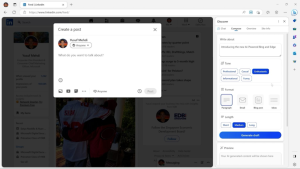Digital Marketing will change with AI, like everything else.
Predicting the precise steps of this future is a challenging quest. What we do know is that foundational shifts in the digital landscape will influence every step of the processes. So, we will look into the various disciplines of digital marketing, analysing the ‘then’ and the ‘now’, and attempting to forecast the ‘next’.
We’re launching this series with a deep dive into Organic Search. We’ll be exploring the implications of AI and look into alternatives in the digital space.
How does Organic search work?
Organic search refers to the search results that are earned rather than paid for. These results are generated based on the relevancy of the content to the search terms (keywords) that users input in search engines like Google, Bing, or Yahoo. Organic search is one of the most crucial parts of search engine optimization (SEO) strategy.
Organic search has its roots in the early days of the internet, when directories like Yahoo (founded in 1994) were manually curated (handpicked listings), and AltaVista (1995) and Google (1997) used automated web crawlers (programs that systematically browse the web to index page information) to index the web. At this time, search engine algorithms (rules and calculations a search engine uses to determine the ranking of websites) were simple and easily manipulated, leading to practices such as keyword stuffing (overusing specific words/phrases in website content to attempt to manipulate search engine rankings) and creating low-quality backlinks (links from other websites to your own, which can affect search rankings). Google’s launch of PageRank (an algorithm that ranked web pages based on the number and quality of links pointing to them) revolutionized the search space by providing more relevant results. In the early 2000s, Google began releasing major updates to its algorithms, such as the “Florida” update in 2003, which penalized keyword stuffing and deceptive tactics (tricks designed to manipulate search engine rankings), marking the beginning of modern SEO (Search Engine Optimization) practices. In 2010, Google introduced the Caffeine update, which improved the speed at which information was indexed (added to the search engine’s database), and in 2011, the Panda update, which prioritized high-quality content (valuable, well-written and unique content). Over the years, many updates, like Penguin in 2012 (targeting spammy link practices) and RankBrain in 2015 (incorporating AI for understanding search queries), continued to refine and improve search results. Today, organic search (search results that are earned rather than paid for) is a sophisticated and evolving field that requires a comprehensive understanding of multiple disciplines, including content creation, on-page optimization (making web pages search-engine friendly), technical SEO (optimizing the website and server aspects to help search engine spiders crawl and index your site more effectively), and off-page strategies (activities performed outside the boundaries of the webpage like link building, social media marketing, etc.), to improve visibility in search engine results.
But the way we search the internet is changing right now based on the tools that we use the most frequent. Right now, Google and YouTube control nearly all of it (98% of it, to be exact).
How Organic Search is changing in times of AI
Organic search is rapidly evolving in the era of AI (Technology used to create systems capable of performing tasks that normally require human intelligence) and social search (search functionality within a social network that includes social behaviour in generating results and searching hashtags, profiles, comments and images). These advances are changing the landscape of search by considering user behaviour, social signals (information gained from social media platforms used for ranking), and personalized preferences to deliver more relevant results.
AI, specifically machine learning (a subset of AI that involves training a model using data to make predictions or decisions without being explicitly programmed), is being leveraged to understand the context and intent behind search queries. Google’s Bart, an AI-based system, interprets complex, long-tail (specific, often multi-word queries) search queries and the context behind them to return better search results. In the first time in a decade, Google is also changed the way we search completely:
SGEs
(SGEs – Search generative results) will play a crucial rule in the way we search in the near future.
You’ll see an AI-powered snapshot of key information to consider, with links to dig deeper.
Below this snapshot, you’ll see suggested next steps, including the ability to ask follow-up questions, like “How long to spend at Bryce Canyon with kids?” When you tap on these, it takes you to a new conversational mode, where you can ask Google more about the topic you’re exploring.
Context will be carried over from question to question, to help you more naturally continue your exploration. You’ll also find helpful jumping-off points to web content and a range of perspectives that you can dig into.
From the SGE Landingpage of Google. https://blog.google/products/search/generative-ai-search/
In a similar manner to how Microsoft, in collaboration with OpenAI, integrated a search box into Bing to offer users the capability to pose queries on websites that would subsequently be answered by an OpenAI-empowered search, Google too introduced a comparable feature known as SGEs. Google’s implementation of SGEs is aimed at employing this search box to gain a deeper understanding of user context and, consequently, to provide direct responses that align with the user’s intent.
In a bid to elevate the user experience within their search results, search engines began incorporating chatbox interfaces. This was perceived as a significant shift in the way users engage with search data. Initial apprehensions emerged that this development could render SEO (Search Engine Optimization) redundant. These fears were primarily rooted in the evolution towards a ‘one-click experience’, where users are served with the information directly within the search engine or chatbox, eliminating the need to visit external websites. However, these concerns have yet to materialize, confirming that while the means of content delivery may evolve, the fundamental need for SEO in driving visibility and accessibility remains crucial. Not forgetting that this also would mean giving up the ad revenue model that made Google so successful in the last decade.
Enriched Search results
Simultaneously, search results enriched with social results is gaining prominence as search engines start to incorporate social context into their search results. This can include personalized search results based on the searcher’s social interactions, as well as real-time indexing of social media content.
The emphasis is increasingly on improving UX (User Experience – the overall experience a user has while interacting with a website or application, including its ease of use and the satisfaction gained from the interaction). Search engines are aiming to provide not just the most relevant results, but also to deliver a seamless and intuitive user journey. This includes efforts to answer more questions directly in the SERPs (Search Engine Results Pages – the pages displayed by search engines in response to a query by a searcher) with featured snippets (selected search results that are featured on top of Google’s organic results below the ads in a box), “People also ask” boxes, and other SERP features.
Furthermore, voice search (a technology that allows users to make a search query by speaking it on a computer or mobile device) is becoming more prevalent due to the proliferation of smart speakers and voice assistants, requiring SEO efforts to consider natural language processing (a field of AI that focuses on the interaction between computers and humans through natural language).
The evolving nature of organic search means that it’s no longer enough to simply optimize for keywords. Now, the focus is on understanding and aligning with user intent (the reason a person types a search into a search engine), creating high-quality content, ensuring a positive user experience, and embracing new technologies and trends.
Hypothetically speaking…
Have a look at this image – When I see this picture, a lot of questions come up.
Why does Sprudge.com show up first? Did they work hard to make that happen, placing links for best coffee shop in berlin? Does location play a role, is sprudge.com a trustworthy source? Where does the text come from? Is it taken from the website, or does the AI make it up? Is it accurate? Is the brand in control of it?
Now given the example above, what do you think is needed to rank your coffee store into the search of OpenAI chatbox for the Berlin area? Links, Likes, rankings in Google? We do not know yet, but it will be certainly interesting.
The biggest skill for Seos will be to influence the AI itself. And, I bet this is already underway. Imagine you are a large producer of coffee beans and you would like to rank your coffee beans in the OpenAI search, for the term “What are best coffee beans?” Hypothetically speaking, you could ask AI to adjust this specific query to make you look like the best choice or even as the only choice. The possibilities to take advantage are endless.
There are many more open questions.
Social Search
You might not be aware of it, but people started already using alternative for google. There is a strong shift towards searching on social sites.. in particular Tiktok:
TikTok Statistics In 2023
- TikTok has over 1.677 billion users as of 2023 out of which 1.06 billion are its monthly active users.
- The United States has over 150 million TikTok users.
- TikTok registered a revenue of $2.475 billion in the first quarter of 2023.
- Over 1 billion videos are viewed on TikTok every day.
- There are over 5 million businesses and countless small businesses on TikTok.
- TikTok has been downloaded over 3.5 billion times to date. It was downloaded 246.9 million times globally in the first quarter of 2023 alone.
- Advertisers can reach around 885 million users aged 18 and above on TikTok.
Source: https://www.demandsage.com/tiktok-user-statistics/
People use Tiktok. A lot. And some use Tiktok more than Google.
TikTok has rapidly grown to become a major player in the social media landscape, especially among the younger demographic. In particular, Generation Z (those born between the mid-to-late 1990s and early 2010s) has shown a significant preference for this platform. As TikTok is essentially a content discovery platform, users often ‘search’ for new content, trends, and information within the app itself.
An interesting trend has emerged where Gen Z users are increasingly relying on TikTok as their primary search engine, often even more than traditional search engines like Google. This shift can be attributed to a few factors:
Format of Content: TikTok’s short-form, highly engaging video content caters to Gen Z’s preferences for concise, visual information and their shorter attention spans.
Authenticity and Relatability: TikTok fosters an environment where raw, authentic content thrives. Gen Z values authenticity and relatability, which is often reflected in the content that becomes popular on TikTok.
Cultural Relevance: The platform is a hotspot for trends, viral challenges, and pop culture content. Gen Z users turn to TikTok not just for entertainment, but also to keep up with what’s trending.
User Participation: TikTok promotes user participation through hashtag challenges, duets, and other interactive features. This active engagement encourages users to spend more time on the platform, further integrating TikTok into their daily habits.
Learning and Discovery: Many users utilize TikTok as a tool for learning. ‘Edutok’, a trend on TikTok, involves creators sharing educational content in various fields.
While it’s important to note that TikTok serves a different purpose compared to Google and may not fully replace it, this trend underscores the evolving search behavior of the younger demographic. It’s important to understand platform-specific user behaviors for businesses and marketers to adapt their strategies to reach their target audiences effectively.
What’s next in organic search
The digital landscape is witnessing profound shifts, particularly with the advent of AI and the rising influence of social media platforms as information sources. These changes are significantly affecting how users search for and interact with content online.
Search engines are evolving, integrating AI and chatbox interfaces to enhance user experience and deliver more accurate, context-based results. While this led to initial apprehensions that SEO might become obsolete, it’s become clear that the core principles of SEO remain vital, even as the methods of content delivery transform.
Moreover, social media platforms like TikTok have become crucial players in the information ecosystem, particularly among younger users. Gen Z’s preference for TikTok’s concise, engaging video content has led to a shift where these users are often using the platform as a primary search and discovery tool, instead of traditional search engines like Google.



